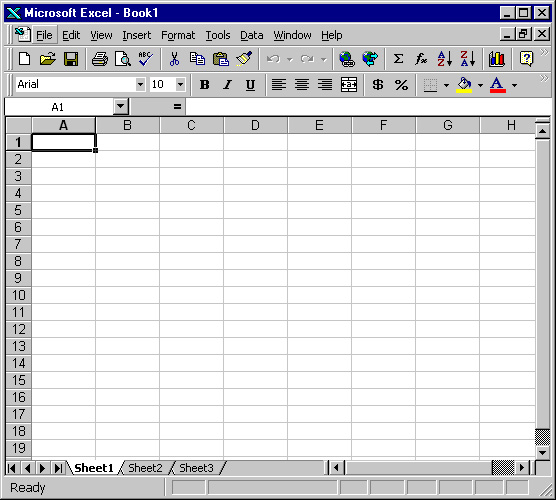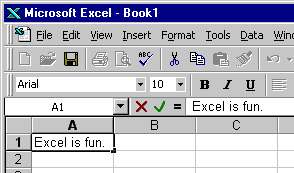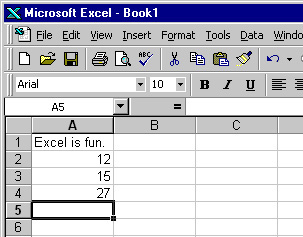
| Main Menu |
 Find and Open Excel 97.
Find and Open Excel 97.
 Resize and position then window displaying the
tutorial next to the blank Excel workbook.
Resize and position then window displaying the
tutorial next to the blank Excel workbook.
 Click on the Excel window, select
a cell by clicking on it, and enter:
Excel is fun.
Click on the Excel window, select
a cell by clicking on it, and enter:
Excel is fun.

 ).
The Cancel and Enter buttons are only
visible while Excel is in edit mode. Excel is in edit
mode anytime you begin typing an entry. To put Excel
in edit mode, click in the formula bar.
).
The Cancel and Enter buttons are only
visible while Excel is in edit mode. Excel is in edit
mode anytime you begin typing an entry. To put Excel
in edit mode, click in the formula bar.
 Within the Excel window, click in the formula
bar to display the Cancel and Enter buttons.
Within the Excel window, click in the formula
bar to display the Cancel and Enter buttons.
 Within the Excel window, click in the
formula bar and change the text: fun,
to outrageous.
Within the Excel window, click in the
formula bar and change the text: fun,
to outrageous.
 Click on the Enter button to enter the
edit.
Click on the Enter button to enter the
edit.
 Click on the Cancel button to cancel the
edit.
Click on the Cancel button to cancel the
edit.
 Within the Excel window, select cell A2 and enter
the constant value 12. (Remeber to click the Enter
button or the Return key when you are done typing).
Within the Excel window, select cell A2 and enter
the constant value 12. (Remeber to click the Enter
button or the Return key when you are done typing).
 Within the Excel window, select cell A3 and enter
the constant value 15.
Within the Excel window, select cell A3 and enter
the constant value 15.
 Within the Excel window, select cell A4 and click on
the formula bar.
Within the Excel window, select cell A4 and click on
the formula bar.
 Within the formula bar, enter an equal sign followed
by A3+A4.
Within the formula bar, enter an equal sign followed
by A3+A4.

 Click on the Enter button or press the
Return key to enter the formula.
Click on the Enter button or press the
Return key to enter the formula.

 Within the Excel window, select cell A3 and change
the number 15 to the number 40, and enter the edit.
Within the Excel window, select cell A3 and change
the number 15 to the number 40, and enter the edit.
| Next Topic: Creating a Workbook |
|
|